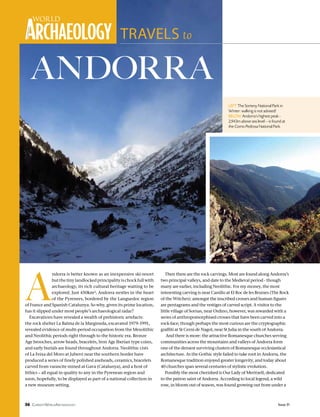Cwa andorra article april may 2012
- 1. 56 Issue 51CurrentWorldArchaeology A ndorra is better known as an inexpensive ski-resort butthetinylandlockedprincipalityischockfullwith archaeology, its rich cultural heritage waiting to be explored. Just 450km┬▓, Andorra nestles in the heart of the Pyrenees, bordered by the Languedoc region of France and Spanish Catalunya. So why, given its prime location, has it slipped under most peopleŌĆÖs archaeological radar? Excavations have revealed a wealth of prehistoric artefacts: the rock shelter La Balma de la Margineda, excavated 1979-1991, revealed evidence of multi-period occupation from the Mesolithic and Neolithic periods right through to the historic era. Bronze Age brooches, arrow heads, bracelets, Iron Age Iberian type coins, and early burials are found throughout Andorra. Neolithic cists of La Feixa del Moro at Juberri near the southern border have produced a series of finely polished axeheads, ceramics, bracelets carved from varascite mined at Gava (Catalunya), and a host of lithics ŌĆō all equal in quality to any in the Pyrenean region and soon, hopefully, to be displayed as part of a national collection in a new museum setting. ANDORRA TRAVELS to Then there are the rock carvings. Most are found along AndorraŌĆÖs two principal valleys, and date to the Medieval period - though many are earlier, including Neolithic. For my money, the most interesting carving is near Canillo at El Roc de les Bruixes (The Rock of the Witches): amongst the inscribed crosses and human figures are pentagrams and the vestiges of carved script. A visitor to the little village of Sornas, near Ordino, however, was rewarded with a series of anthropomorphised crosses that have been carved into a rock-face; though perhaps the most curious are the cryptographic graffiti at St Cerni de Nagol, near St Julia in the south of Andorra. And there is more: the attractive Romanesque churches serving communities across the mountains and valleys of Andorra form one of the densest surviving clusters of Romanesque ecclesiastical architecture. As the Gothic style failed to take root in Andorra, the Romanesque tradition enjoyed greater longevity, and today about 40 churches span several centuries of stylistic evolution. Possibly the most cherished is Our Lady of Meritxell, dedicated to the patron saint of Andorra. According to local legend, a wild rose, in bloom out of season, was found growing out from under a left The Sorteny National Park in Winter: walking is not advised! below AndorraŌĆÖs highest peak - 2,943m above sea level ŌĆō is found at the Como Pedrosa National Park.
- 2. www.world-archaeology.com 57CurrentWorldArchaeology statue of the Virgin and Child at this spot in the late 12th century. Each time the statue was moved, it found its way back to the wild rose. So, a chapel was built here to accommodate the miraculous statue, and which became the focus of annual pilgrimages each September. Sadly, in 1972, the original Romanesque chapel burned to the ground and the statue was destroyed and today a distinctly modern, yet still attractive, church stands on its footprint. Also worth visiting are the 11th century St Joan de Caselles in Canillo, with its Lombard style bell-tower and murals; and the 12th century St Miquel d'Engolasters, with its 17m bell tower sporting, unusually, a carved human face on one of the uppermost sides. One of my favourites is the tiny St Rom├Ā de les Bon in Encamp, a FRANCE TRAVELandorra FURTHER INFORMATION details: The churches are open in July and August with guides, and by appointment at other times. Andorra has no airport or railway station but is easily accessible by road. Regular buses run between the capital La Vella and airports at Toulouse, Girona, and (most frequently) Barcelona. No visas required. The national language is Catalan but Spanish and some French are spoken. Currency is the Euro. Website: www.andorra.ad TheauthorthanksAlbertEsteve(MinisterofCulture),archaeologistsAlexVidal andGerardRemolins,JudyHill,andLauraFrigolafortheirhelp. 12th century church with stunning interior wall paintings that depict the apocalyptic visions of St John; beside it lie the remains of a 13th century defence tower, the only one in Andorra. Before you leave, for a fascinating insight into in AndorraŌĆÖs everyday past, be sure to visit three 17th century houses that are now museums: the Areny-Plandolit house, Casa Rull, and Casa Christo. Martin Locker, a frequent visitor to Andorra, is writing his doctorate on Medieval pilgrimages at the Institute of Archaeology, UCL. Madriu-Perafita-Claror valley The Madriu-Perafita-Claror valley is described by UNESCO as a ŌĆśmicrocosmic perspective of the way people have harvested the resources of the high Pyrenees over millennia. Archaeological evidence of Medieval summer settlement, field terracing, and iron smelting have been uncovered. The remains of shepherdŌĆÖs huts, sheep pens, dry-stone walls and charcoal-making sites are still visible in the valley floor and woodland. ’éż above A view from the Sorteny National Park in northern Andorra. left The 11th century Romanesque church of Sant Miquel d'Engolasters ŌĆō note the carved head below the roof of the tower. below The 12th century Romanesque church at St Roma les Bons, Encamp. SPAIN


